Justice and Human Rights: Proactive Policing, Crime Control Model, Just Deserts, Magistrate Court vs Crown Court, Restorative Justice, Does Prison Work?
VerifiedAdded on 2022/12/30
|10
|3345
|34
AI Summary
This document discusses various topics related to justice and human rights, including proactive policing, the crime control model, just deserts, differences between magistrate court and crown court, core principles of restorative justice, and the effectiveness of prisons. It explores the concepts, differences, and debates surrounding these topics, providing a comprehensive overview. The document also touches upon the relationship between imprisonment and human rights, discussing the arguments for and against the effectiveness of prisons in achieving their aims while considering human rights.
Contribute Materials
Your contribution can guide someone’s learning journey. Share your
documents today.
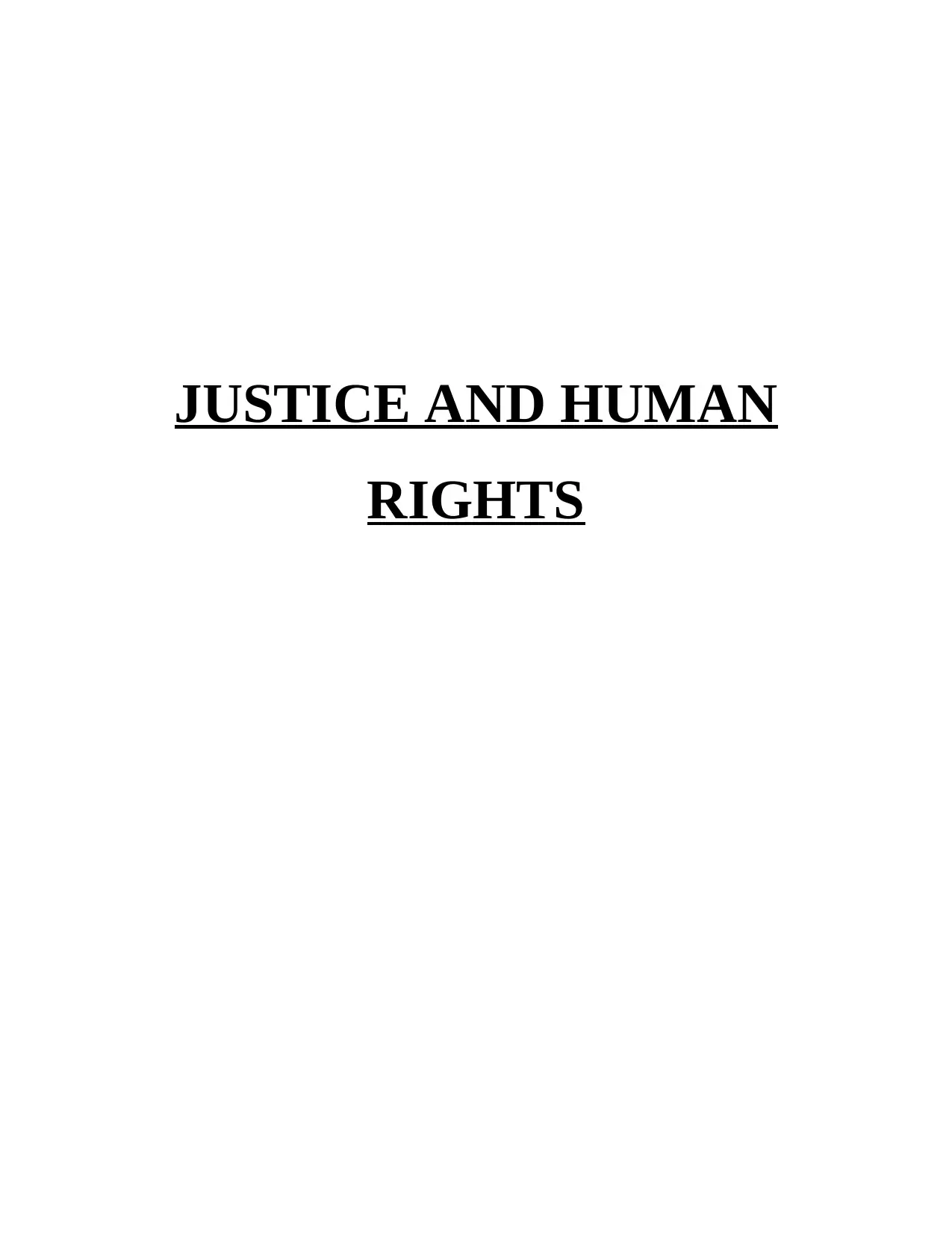
JUSTICE AND HUMAN
RIGHTS
RIGHTS
Secure Best Marks with AI Grader
Need help grading? Try our AI Grader for instant feedback on your assignments.
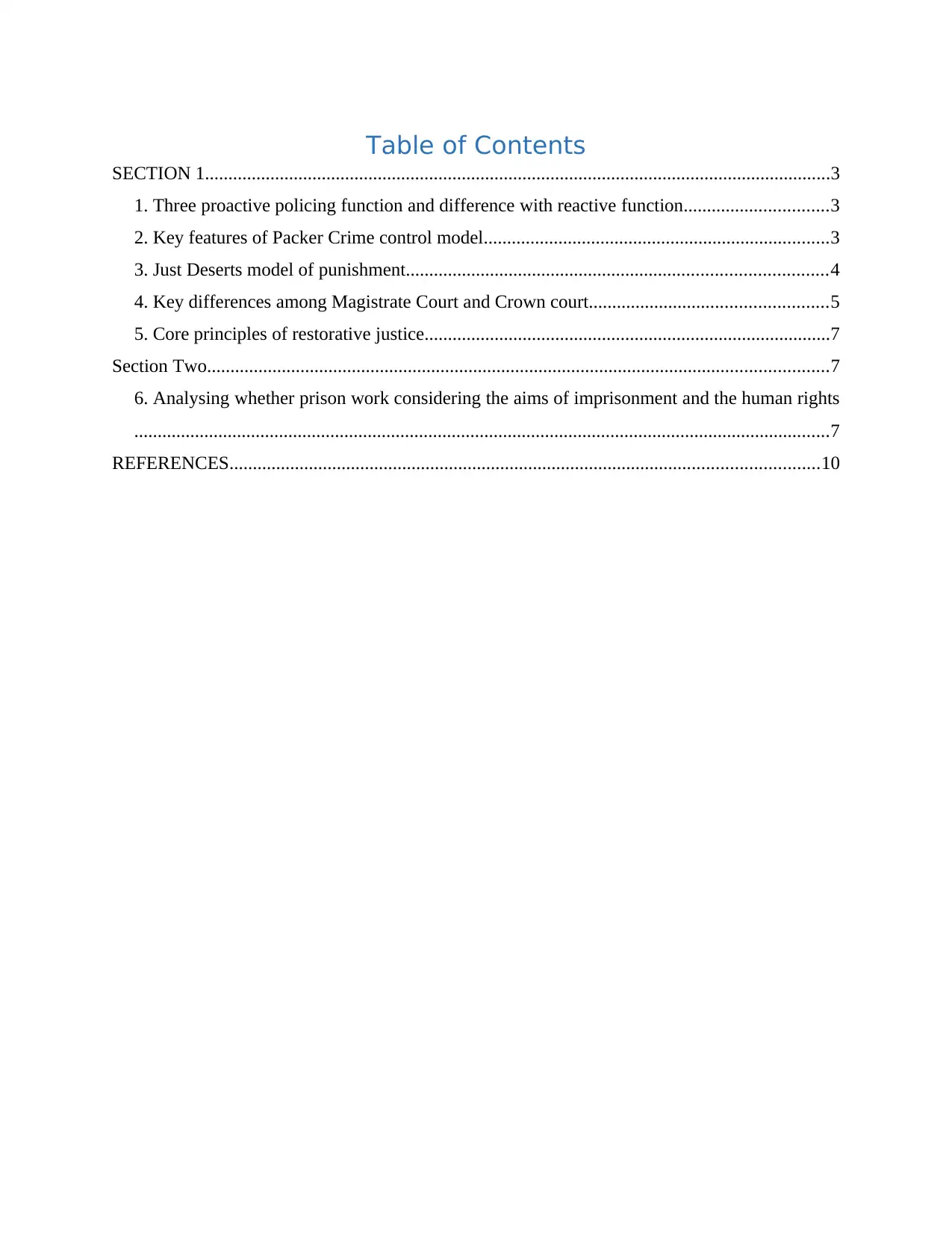
Table of Contents
SECTION 1......................................................................................................................................3
1. Three proactive policing function and difference with reactive function...............................3
2. Key features of Packer Crime control model..........................................................................3
3. Just Deserts model of punishment..........................................................................................4
4. Key differences among Magistrate Court and Crown court...................................................5
5. Core principles of restorative justice.......................................................................................7
Section Two.....................................................................................................................................7
6. Analysing whether prison work considering the aims of imprisonment and the human rights
.....................................................................................................................................................7
REFERENCES..............................................................................................................................10
SECTION 1......................................................................................................................................3
1. Three proactive policing function and difference with reactive function...............................3
2. Key features of Packer Crime control model..........................................................................3
3. Just Deserts model of punishment..........................................................................................4
4. Key differences among Magistrate Court and Crown court...................................................5
5. Core principles of restorative justice.......................................................................................7
Section Two.....................................................................................................................................7
6. Analysing whether prison work considering the aims of imprisonment and the human rights
.....................................................................................................................................................7
REFERENCES..............................................................................................................................10
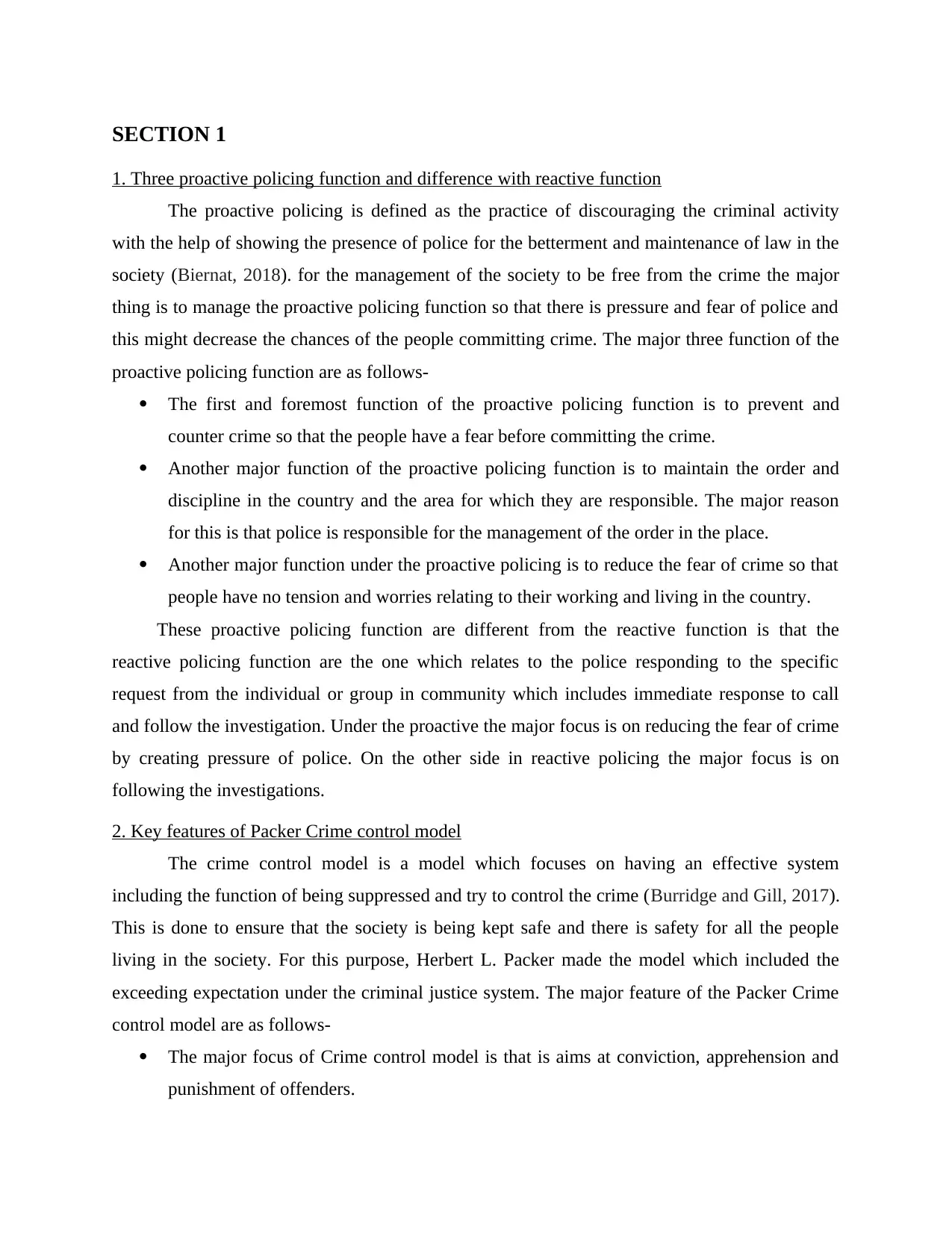
SECTION 1
1. Three proactive policing function and difference with reactive function
The proactive policing is defined as the practice of discouraging the criminal activity
with the help of showing the presence of police for the betterment and maintenance of law in the
society (Biernat, 2018). for the management of the society to be free from the crime the major
thing is to manage the proactive policing function so that there is pressure and fear of police and
this might decrease the chances of the people committing crime. The major three function of the
proactive policing function are as follows-
The first and foremost function of the proactive policing function is to prevent and
counter crime so that the people have a fear before committing the crime.
Another major function of the proactive policing function is to maintain the order and
discipline in the country and the area for which they are responsible. The major reason
for this is that police is responsible for the management of the order in the place.
Another major function under the proactive policing is to reduce the fear of crime so that
people have no tension and worries relating to their working and living in the country.
These proactive policing function are different from the reactive function is that the
reactive policing function are the one which relates to the police responding to the specific
request from the individual or group in community which includes immediate response to call
and follow the investigation. Under the proactive the major focus is on reducing the fear of crime
by creating pressure of police. On the other side in reactive policing the major focus is on
following the investigations.
2. Key features of Packer Crime control model
The crime control model is a model which focuses on having an effective system
including the function of being suppressed and try to control the crime (Burridge and Gill, 2017).
This is done to ensure that the society is being kept safe and there is safety for all the people
living in the society. For this purpose, Herbert L. Packer made the model which included the
exceeding expectation under the criminal justice system. The major feature of the Packer Crime
control model are as follows-
The major focus of Crime control model is that is aims at conviction, apprehension and
punishment of offenders.
1. Three proactive policing function and difference with reactive function
The proactive policing is defined as the practice of discouraging the criminal activity
with the help of showing the presence of police for the betterment and maintenance of law in the
society (Biernat, 2018). for the management of the society to be free from the crime the major
thing is to manage the proactive policing function so that there is pressure and fear of police and
this might decrease the chances of the people committing crime. The major three function of the
proactive policing function are as follows-
The first and foremost function of the proactive policing function is to prevent and
counter crime so that the people have a fear before committing the crime.
Another major function of the proactive policing function is to maintain the order and
discipline in the country and the area for which they are responsible. The major reason
for this is that police is responsible for the management of the order in the place.
Another major function under the proactive policing is to reduce the fear of crime so that
people have no tension and worries relating to their working and living in the country.
These proactive policing function are different from the reactive function is that the
reactive policing function are the one which relates to the police responding to the specific
request from the individual or group in community which includes immediate response to call
and follow the investigation. Under the proactive the major focus is on reducing the fear of crime
by creating pressure of police. On the other side in reactive policing the major focus is on
following the investigations.
2. Key features of Packer Crime control model
The crime control model is a model which focuses on having an effective system
including the function of being suppressed and try to control the crime (Burridge and Gill, 2017).
This is done to ensure that the society is being kept safe and there is safety for all the people
living in the society. For this purpose, Herbert L. Packer made the model which included the
exceeding expectation under the criminal justice system. The major feature of the Packer Crime
control model are as follows-
The major focus of Crime control model is that is aims at conviction, apprehension and
punishment of offenders.
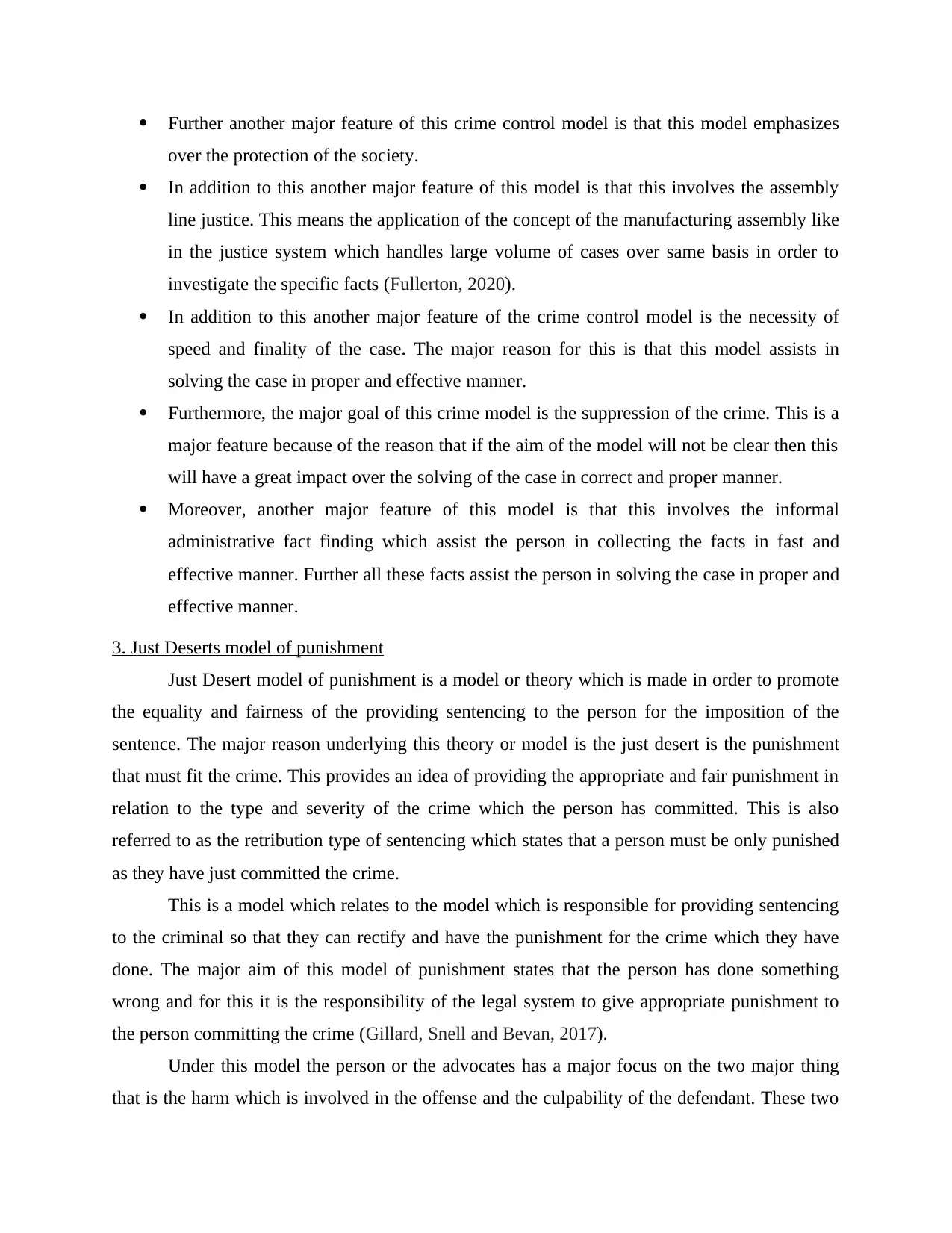
Further another major feature of this crime control model is that this model emphasizes
over the protection of the society.
In addition to this another major feature of this model is that this involves the assembly
line justice. This means the application of the concept of the manufacturing assembly like
in the justice system which handles large volume of cases over same basis in order to
investigate the specific facts (Fullerton, 2020).
In addition to this another major feature of the crime control model is the necessity of
speed and finality of the case. The major reason for this is that this model assists in
solving the case in proper and effective manner.
Furthermore, the major goal of this crime model is the suppression of the crime. This is a
major feature because of the reason that if the aim of the model will not be clear then this
will have a great impact over the solving of the case in correct and proper manner.
Moreover, another major feature of this model is that this involves the informal
administrative fact finding which assist the person in collecting the facts in fast and
effective manner. Further all these facts assist the person in solving the case in proper and
effective manner.
3. Just Deserts model of punishment
Just Desert model of punishment is a model or theory which is made in order to promote
the equality and fairness of the providing sentencing to the person for the imposition of the
sentence. The major reason underlying this theory or model is the just desert is the punishment
that must fit the crime. This provides an idea of providing the appropriate and fair punishment in
relation to the type and severity of the crime which the person has committed. This is also
referred to as the retribution type of sentencing which states that a person must be only punished
as they have just committed the crime.
This is a model which relates to the model which is responsible for providing sentencing
to the criminal so that they can rectify and have the punishment for the crime which they have
done. The major aim of this model of punishment states that the person has done something
wrong and for this it is the responsibility of the legal system to give appropriate punishment to
the person committing the crime (Gillard, Snell and Bevan, 2017).
Under this model the person or the advocates has a major focus on the two major thing
that is the harm which is involved in the offense and the culpability of the defendant. These two
over the protection of the society.
In addition to this another major feature of this model is that this involves the assembly
line justice. This means the application of the concept of the manufacturing assembly like
in the justice system which handles large volume of cases over same basis in order to
investigate the specific facts (Fullerton, 2020).
In addition to this another major feature of the crime control model is the necessity of
speed and finality of the case. The major reason for this is that this model assists in
solving the case in proper and effective manner.
Furthermore, the major goal of this crime model is the suppression of the crime. This is a
major feature because of the reason that if the aim of the model will not be clear then this
will have a great impact over the solving of the case in correct and proper manner.
Moreover, another major feature of this model is that this involves the informal
administrative fact finding which assist the person in collecting the facts in fast and
effective manner. Further all these facts assist the person in solving the case in proper and
effective manner.
3. Just Deserts model of punishment
Just Desert model of punishment is a model or theory which is made in order to promote
the equality and fairness of the providing sentencing to the person for the imposition of the
sentence. The major reason underlying this theory or model is the just desert is the punishment
that must fit the crime. This provides an idea of providing the appropriate and fair punishment in
relation to the type and severity of the crime which the person has committed. This is also
referred to as the retribution type of sentencing which states that a person must be only punished
as they have just committed the crime.
This is a model which relates to the model which is responsible for providing sentencing
to the criminal so that they can rectify and have the punishment for the crime which they have
done. The major aim of this model of punishment states that the person has done something
wrong and for this it is the responsibility of the legal system to give appropriate punishment to
the person committing the crime (Gillard, Snell and Bevan, 2017).
Under this model the person or the advocates has a major focus on the two major thing
that is the harm which is involved in the offense and the culpability of the defendant. These two
Secure Best Marks with AI Grader
Need help grading? Try our AI Grader for instant feedback on your assignments.
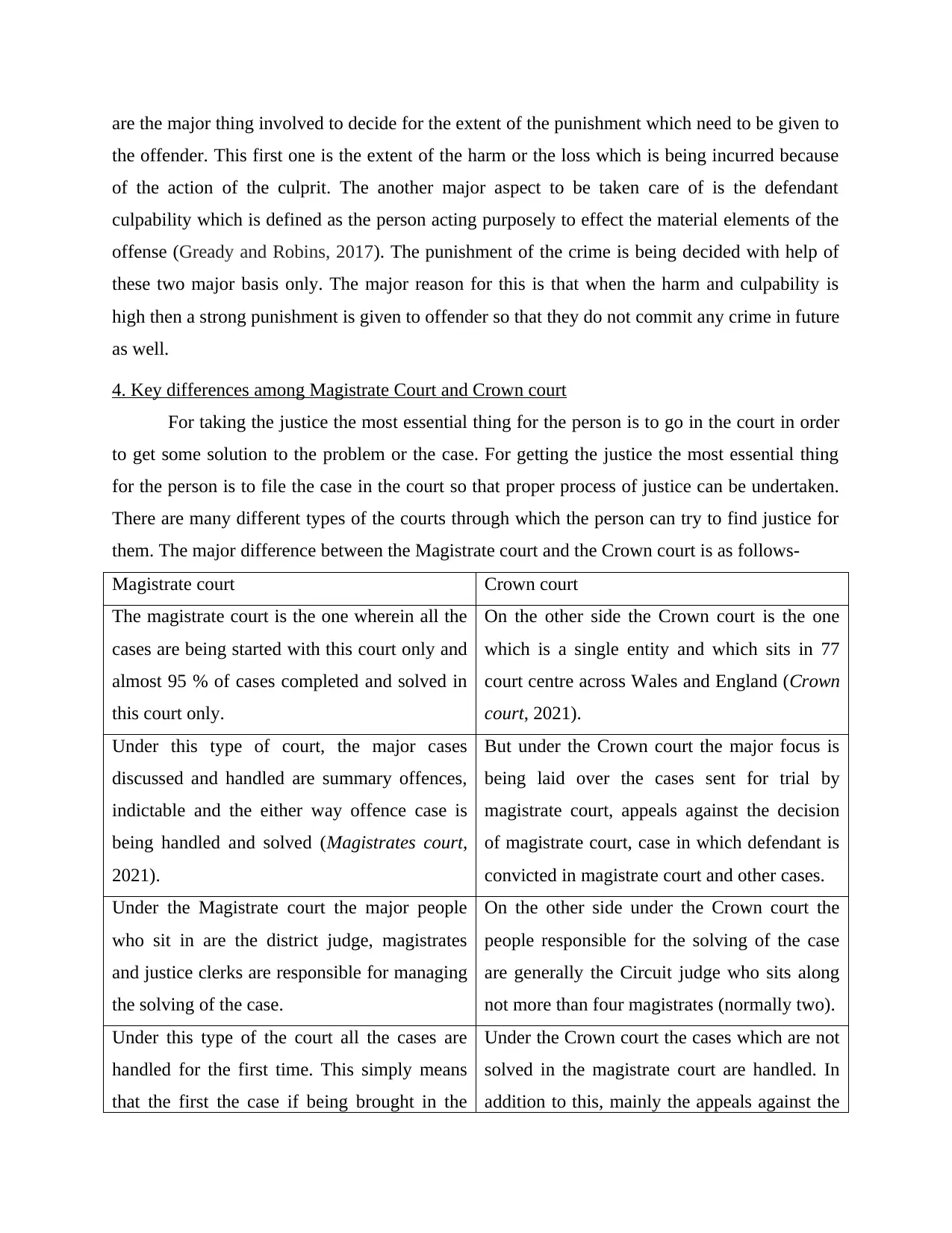
are the major thing involved to decide for the extent of the punishment which need to be given to
the offender. This first one is the extent of the harm or the loss which is being incurred because
of the action of the culprit. The another major aspect to be taken care of is the defendant
culpability which is defined as the person acting purposely to effect the material elements of the
offense (Gready and Robins, 2017). The punishment of the crime is being decided with help of
these two major basis only. The major reason for this is that when the harm and culpability is
high then a strong punishment is given to offender so that they do not commit any crime in future
as well.
4. Key differences among Magistrate Court and Crown court
For taking the justice the most essential thing for the person is to go in the court in order
to get some solution to the problem or the case. For getting the justice the most essential thing
for the person is to file the case in the court so that proper process of justice can be undertaken.
There are many different types of the courts through which the person can try to find justice for
them. The major difference between the Magistrate court and the Crown court is as follows-
Magistrate court Crown court
The magistrate court is the one wherein all the
cases are being started with this court only and
almost 95 % of cases completed and solved in
this court only.
On the other side the Crown court is the one
which is a single entity and which sits in 77
court centre across Wales and England (Crown
court, 2021).
Under this type of court, the major cases
discussed and handled are summary offences,
indictable and the either way offence case is
being handled and solved (Magistrates court,
2021).
But under the Crown court the major focus is
being laid over the cases sent for trial by
magistrate court, appeals against the decision
of magistrate court, case in which defendant is
convicted in magistrate court and other cases.
Under the Magistrate court the major people
who sit in are the district judge, magistrates
and justice clerks are responsible for managing
the solving of the case.
On the other side under the Crown court the
people responsible for the solving of the case
are generally the Circuit judge who sits along
not more than four magistrates (normally two).
Under this type of the court all the cases are
handled for the first time. This simply means
that the first the case if being brought in the
Under the Crown court the cases which are not
solved in the magistrate court are handled. In
addition to this, mainly the appeals against the
the offender. This first one is the extent of the harm or the loss which is being incurred because
of the action of the culprit. The another major aspect to be taken care of is the defendant
culpability which is defined as the person acting purposely to effect the material elements of the
offense (Gready and Robins, 2017). The punishment of the crime is being decided with help of
these two major basis only. The major reason for this is that when the harm and culpability is
high then a strong punishment is given to offender so that they do not commit any crime in future
as well.
4. Key differences among Magistrate Court and Crown court
For taking the justice the most essential thing for the person is to go in the court in order
to get some solution to the problem or the case. For getting the justice the most essential thing
for the person is to file the case in the court so that proper process of justice can be undertaken.
There are many different types of the courts through which the person can try to find justice for
them. The major difference between the Magistrate court and the Crown court is as follows-
Magistrate court Crown court
The magistrate court is the one wherein all the
cases are being started with this court only and
almost 95 % of cases completed and solved in
this court only.
On the other side the Crown court is the one
which is a single entity and which sits in 77
court centre across Wales and England (Crown
court, 2021).
Under this type of court, the major cases
discussed and handled are summary offences,
indictable and the either way offence case is
being handled and solved (Magistrates court,
2021).
But under the Crown court the major focus is
being laid over the cases sent for trial by
magistrate court, appeals against the decision
of magistrate court, case in which defendant is
convicted in magistrate court and other cases.
Under the Magistrate court the major people
who sit in are the district judge, magistrates
and justice clerks are responsible for managing
the solving of the case.
On the other side under the Crown court the
people responsible for the solving of the case
are generally the Circuit judge who sits along
not more than four magistrates (normally two).
Under this type of the court all the cases are
handled for the first time. This simply means
that the first the case if being brought in the
Under the Crown court the cases which are not
solved in the magistrate court are handled. In
addition to this, mainly the appeals against the

magistrate court for solution. conviction of the criminal offence from the
magistrate courts are handled and solved.
magistrate courts are handled and solved.
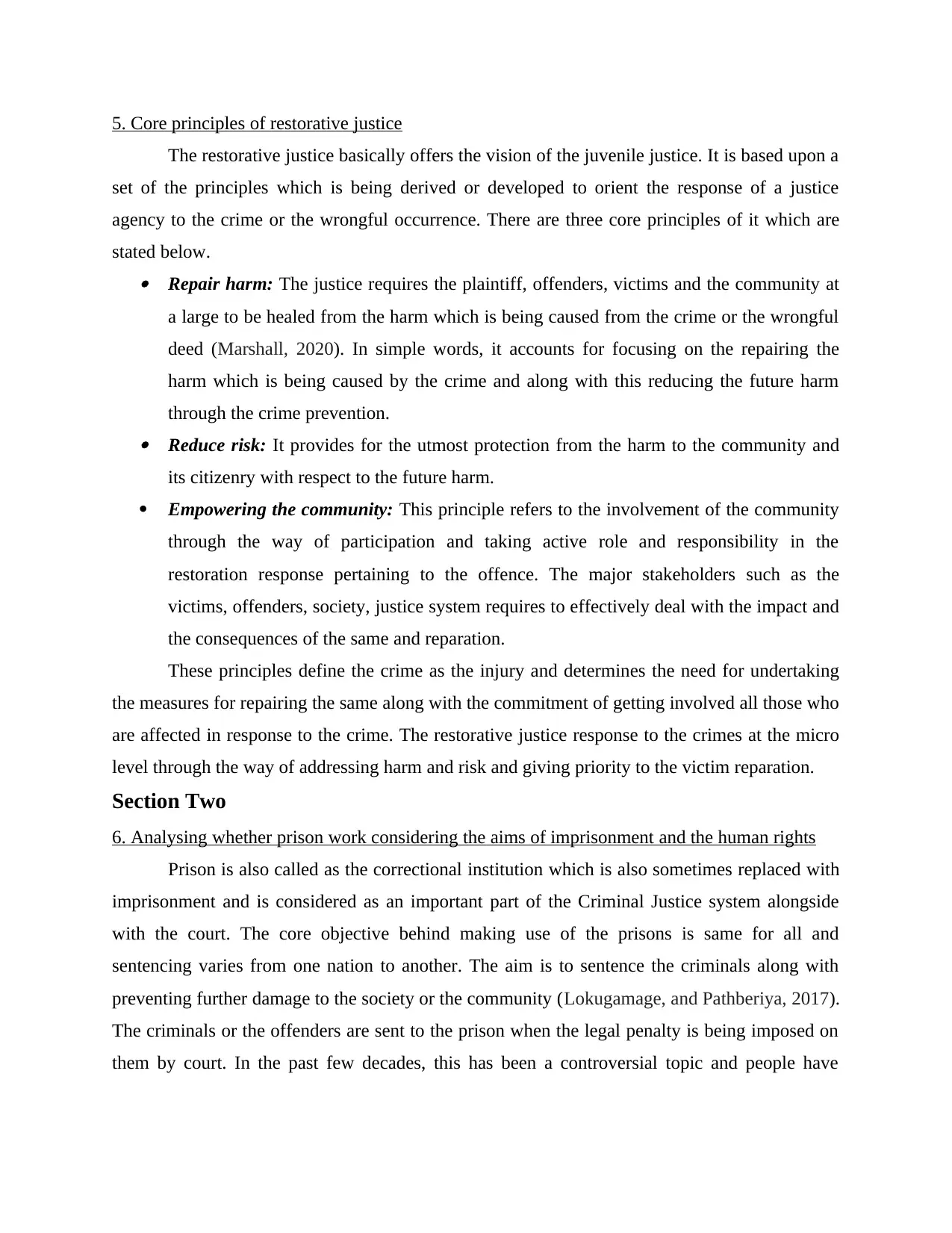
5. Core principles of restorative justice
The restorative justice basically offers the vision of the juvenile justice. It is based upon a
set of the principles which is being derived or developed to orient the response of a justice
agency to the crime or the wrongful occurrence. There are three core principles of it which are
stated below. Repair harm: The justice requires the plaintiff, offenders, victims and the community at
a large to be healed from the harm which is being caused from the crime or the wrongful
deed (Marshall, 2020). In simple words, it accounts for focusing on the repairing the
harm which is being caused by the crime and along with this reducing the future harm
through the crime prevention. Reduce risk: It provides for the utmost protection from the harm to the community and
its citizenry with respect to the future harm.
Empowering the community: This principle refers to the involvement of the community
through the way of participation and taking active role and responsibility in the
restoration response pertaining to the offence. The major stakeholders such as the
victims, offenders, society, justice system requires to effectively deal with the impact and
the consequences of the same and reparation.
These principles define the crime as the injury and determines the need for undertaking
the measures for repairing the same along with the commitment of getting involved all those who
are affected in response to the crime. The restorative justice response to the crimes at the micro
level through the way of addressing harm and risk and giving priority to the victim reparation.
Section Two
6. Analysing whether prison work considering the aims of imprisonment and the human rights
Prison is also called as the correctional institution which is also sometimes replaced with
imprisonment and is considered as an important part of the Criminal Justice system alongside
with the court. The core objective behind making use of the prisons is same for all and
sentencing varies from one nation to another. The aim is to sentence the criminals along with
preventing further damage to the society or the community (Lokugamage, and Pathberiya, 2017).
The criminals or the offenders are sent to the prison when the legal penalty is being imposed on
them by court. In the past few decades, this has been a controversial topic and people have
The restorative justice basically offers the vision of the juvenile justice. It is based upon a
set of the principles which is being derived or developed to orient the response of a justice
agency to the crime or the wrongful occurrence. There are three core principles of it which are
stated below. Repair harm: The justice requires the plaintiff, offenders, victims and the community at
a large to be healed from the harm which is being caused from the crime or the wrongful
deed (Marshall, 2020). In simple words, it accounts for focusing on the repairing the
harm which is being caused by the crime and along with this reducing the future harm
through the crime prevention. Reduce risk: It provides for the utmost protection from the harm to the community and
its citizenry with respect to the future harm.
Empowering the community: This principle refers to the involvement of the community
through the way of participation and taking active role and responsibility in the
restoration response pertaining to the offence. The major stakeholders such as the
victims, offenders, society, justice system requires to effectively deal with the impact and
the consequences of the same and reparation.
These principles define the crime as the injury and determines the need for undertaking
the measures for repairing the same along with the commitment of getting involved all those who
are affected in response to the crime. The restorative justice response to the crimes at the micro
level through the way of addressing harm and risk and giving priority to the victim reparation.
Section Two
6. Analysing whether prison work considering the aims of imprisonment and the human rights
Prison is also called as the correctional institution which is also sometimes replaced with
imprisonment and is considered as an important part of the Criminal Justice system alongside
with the court. The core objective behind making use of the prisons is same for all and
sentencing varies from one nation to another. The aim is to sentence the criminals along with
preventing further damage to the society or the community (Lokugamage, and Pathberiya, 2017).
The criminals or the offenders are sent to the prison when the legal penalty is being imposed on
them by court. In the past few decades, this has been a controversial topic and people have
Paraphrase This Document
Need a fresh take? Get an instant paraphrase of this document with our AI Paraphraser
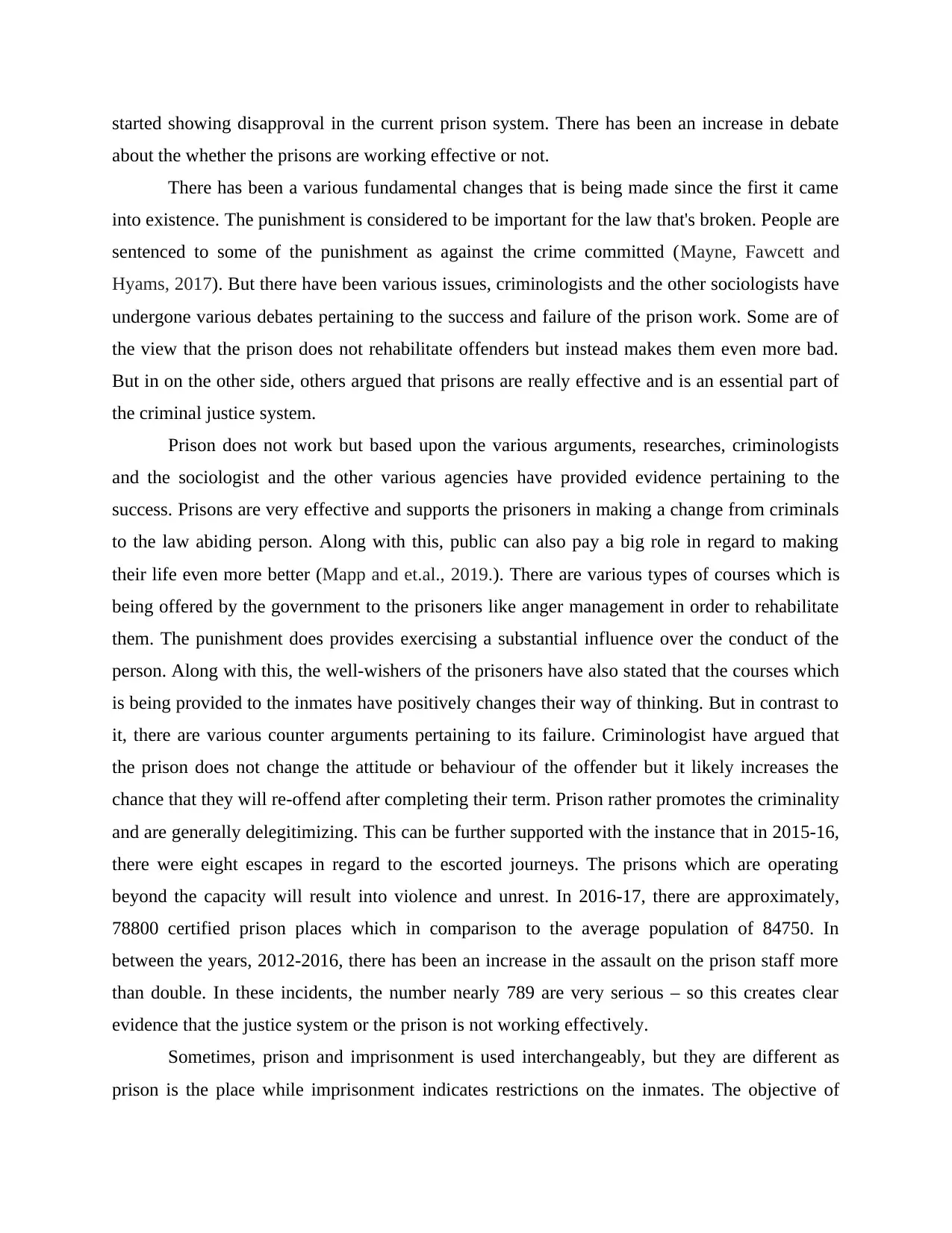
started showing disapproval in the current prison system. There has been an increase in debate
about the whether the prisons are working effective or not.
There has been a various fundamental changes that is being made since the first it came
into existence. The punishment is considered to be important for the law that's broken. People are
sentenced to some of the punishment as against the crime committed (Mayne, Fawcett and
Hyams, 2017). But there have been various issues, criminologists and the other sociologists have
undergone various debates pertaining to the success and failure of the prison work. Some are of
the view that the prison does not rehabilitate offenders but instead makes them even more bad.
But in on the other side, others argued that prisons are really effective and is an essential part of
the criminal justice system.
Prison does not work but based upon the various arguments, researches, criminologists
and the sociologist and the other various agencies have provided evidence pertaining to the
success. Prisons are very effective and supports the prisoners in making a change from criminals
to the law abiding person. Along with this, public can also pay a big role in regard to making
their life even more better (Mapp and et.al., 2019.). There are various types of courses which is
being offered by the government to the prisoners like anger management in order to rehabilitate
them. The punishment does provides exercising a substantial influence over the conduct of the
person. Along with this, the well-wishers of the prisoners have also stated that the courses which
is being provided to the inmates have positively changes their way of thinking. But in contrast to
it, there are various counter arguments pertaining to its failure. Criminologist have argued that
the prison does not change the attitude or behaviour of the offender but it likely increases the
chance that they will re-offend after completing their term. Prison rather promotes the criminality
and are generally delegitimizing. This can be further supported with the instance that in 2015-16,
there were eight escapes in regard to the escorted journeys. The prisons which are operating
beyond the capacity will result into violence and unrest. In 2016-17, there are approximately,
78800 certified prison places which in comparison to the average population of 84750. In
between the years, 2012-2016, there has been an increase in the assault on the prison staff more
than double. In these incidents, the number nearly 789 are very serious – so this creates clear
evidence that the justice system or the prison is not working effectively.
Sometimes, prison and imprisonment is used interchangeably, but they are different as
prison is the place while imprisonment indicates restrictions on the inmates. The objective of
about the whether the prisons are working effective or not.
There has been a various fundamental changes that is being made since the first it came
into existence. The punishment is considered to be important for the law that's broken. People are
sentenced to some of the punishment as against the crime committed (Mayne, Fawcett and
Hyams, 2017). But there have been various issues, criminologists and the other sociologists have
undergone various debates pertaining to the success and failure of the prison work. Some are of
the view that the prison does not rehabilitate offenders but instead makes them even more bad.
But in on the other side, others argued that prisons are really effective and is an essential part of
the criminal justice system.
Prison does not work but based upon the various arguments, researches, criminologists
and the sociologist and the other various agencies have provided evidence pertaining to the
success. Prisons are very effective and supports the prisoners in making a change from criminals
to the law abiding person. Along with this, public can also pay a big role in regard to making
their life even more better (Mapp and et.al., 2019.). There are various types of courses which is
being offered by the government to the prisoners like anger management in order to rehabilitate
them. The punishment does provides exercising a substantial influence over the conduct of the
person. Along with this, the well-wishers of the prisoners have also stated that the courses which
is being provided to the inmates have positively changes their way of thinking. But in contrast to
it, there are various counter arguments pertaining to its failure. Criminologist have argued that
the prison does not change the attitude or behaviour of the offender but it likely increases the
chance that they will re-offend after completing their term. Prison rather promotes the criminality
and are generally delegitimizing. This can be further supported with the instance that in 2015-16,
there were eight escapes in regard to the escorted journeys. The prisons which are operating
beyond the capacity will result into violence and unrest. In 2016-17, there are approximately,
78800 certified prison places which in comparison to the average population of 84750. In
between the years, 2012-2016, there has been an increase in the assault on the prison staff more
than double. In these incidents, the number nearly 789 are very serious – so this creates clear
evidence that the justice system or the prison is not working effectively.
Sometimes, prison and imprisonment is used interchangeably, but they are different as
prison is the place while imprisonment indicates restrictions on the inmates. The objective of
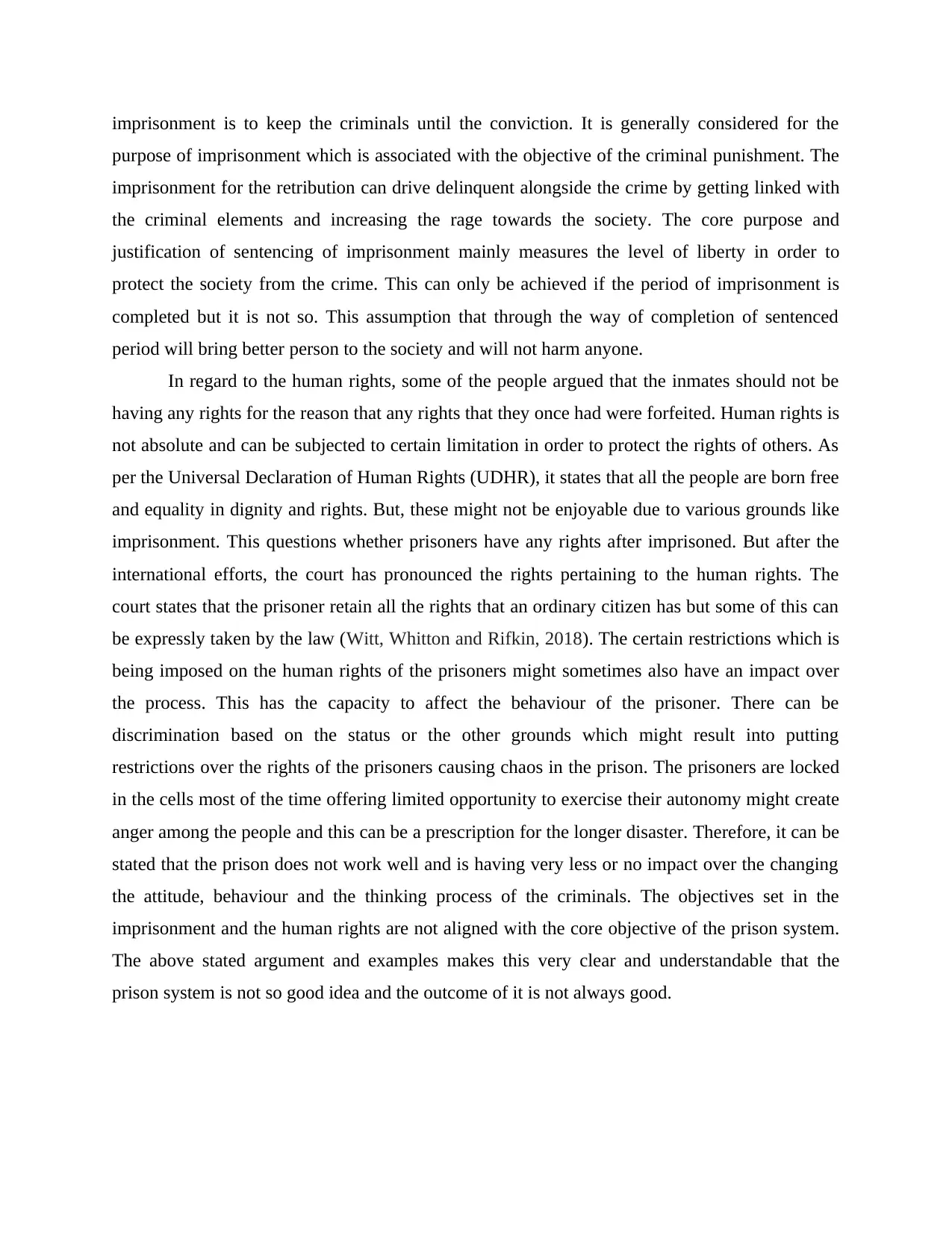
imprisonment is to keep the criminals until the conviction. It is generally considered for the
purpose of imprisonment which is associated with the objective of the criminal punishment. The
imprisonment for the retribution can drive delinquent alongside the crime by getting linked with
the criminal elements and increasing the rage towards the society. The core purpose and
justification of sentencing of imprisonment mainly measures the level of liberty in order to
protect the society from the crime. This can only be achieved if the period of imprisonment is
completed but it is not so. This assumption that through the way of completion of sentenced
period will bring better person to the society and will not harm anyone.
In regard to the human rights, some of the people argued that the inmates should not be
having any rights for the reason that any rights that they once had were forfeited. Human rights is
not absolute and can be subjected to certain limitation in order to protect the rights of others. As
per the Universal Declaration of Human Rights (UDHR), it states that all the people are born free
and equality in dignity and rights. But, these might not be enjoyable due to various grounds like
imprisonment. This questions whether prisoners have any rights after imprisoned. But after the
international efforts, the court has pronounced the rights pertaining to the human rights. The
court states that the prisoner retain all the rights that an ordinary citizen has but some of this can
be expressly taken by the law (Witt, Whitton and Rifkin, 2018). The certain restrictions which is
being imposed on the human rights of the prisoners might sometimes also have an impact over
the process. This has the capacity to affect the behaviour of the prisoner. There can be
discrimination based on the status or the other grounds which might result into putting
restrictions over the rights of the prisoners causing chaos in the prison. The prisoners are locked
in the cells most of the time offering limited opportunity to exercise their autonomy might create
anger among the people and this can be a prescription for the longer disaster. Therefore, it can be
stated that the prison does not work well and is having very less or no impact over the changing
the attitude, behaviour and the thinking process of the criminals. The objectives set in the
imprisonment and the human rights are not aligned with the core objective of the prison system.
The above stated argument and examples makes this very clear and understandable that the
prison system is not so good idea and the outcome of it is not always good.
purpose of imprisonment which is associated with the objective of the criminal punishment. The
imprisonment for the retribution can drive delinquent alongside the crime by getting linked with
the criminal elements and increasing the rage towards the society. The core purpose and
justification of sentencing of imprisonment mainly measures the level of liberty in order to
protect the society from the crime. This can only be achieved if the period of imprisonment is
completed but it is not so. This assumption that through the way of completion of sentenced
period will bring better person to the society and will not harm anyone.
In regard to the human rights, some of the people argued that the inmates should not be
having any rights for the reason that any rights that they once had were forfeited. Human rights is
not absolute and can be subjected to certain limitation in order to protect the rights of others. As
per the Universal Declaration of Human Rights (UDHR), it states that all the people are born free
and equality in dignity and rights. But, these might not be enjoyable due to various grounds like
imprisonment. This questions whether prisoners have any rights after imprisoned. But after the
international efforts, the court has pronounced the rights pertaining to the human rights. The
court states that the prisoner retain all the rights that an ordinary citizen has but some of this can
be expressly taken by the law (Witt, Whitton and Rifkin, 2018). The certain restrictions which is
being imposed on the human rights of the prisoners might sometimes also have an impact over
the process. This has the capacity to affect the behaviour of the prisoner. There can be
discrimination based on the status or the other grounds which might result into putting
restrictions over the rights of the prisoners causing chaos in the prison. The prisoners are locked
in the cells most of the time offering limited opportunity to exercise their autonomy might create
anger among the people and this can be a prescription for the longer disaster. Therefore, it can be
stated that the prison does not work well and is having very less or no impact over the changing
the attitude, behaviour and the thinking process of the criminals. The objectives set in the
imprisonment and the human rights are not aligned with the core objective of the prison system.
The above stated argument and examples makes this very clear and understandable that the
prison system is not so good idea and the outcome of it is not always good.
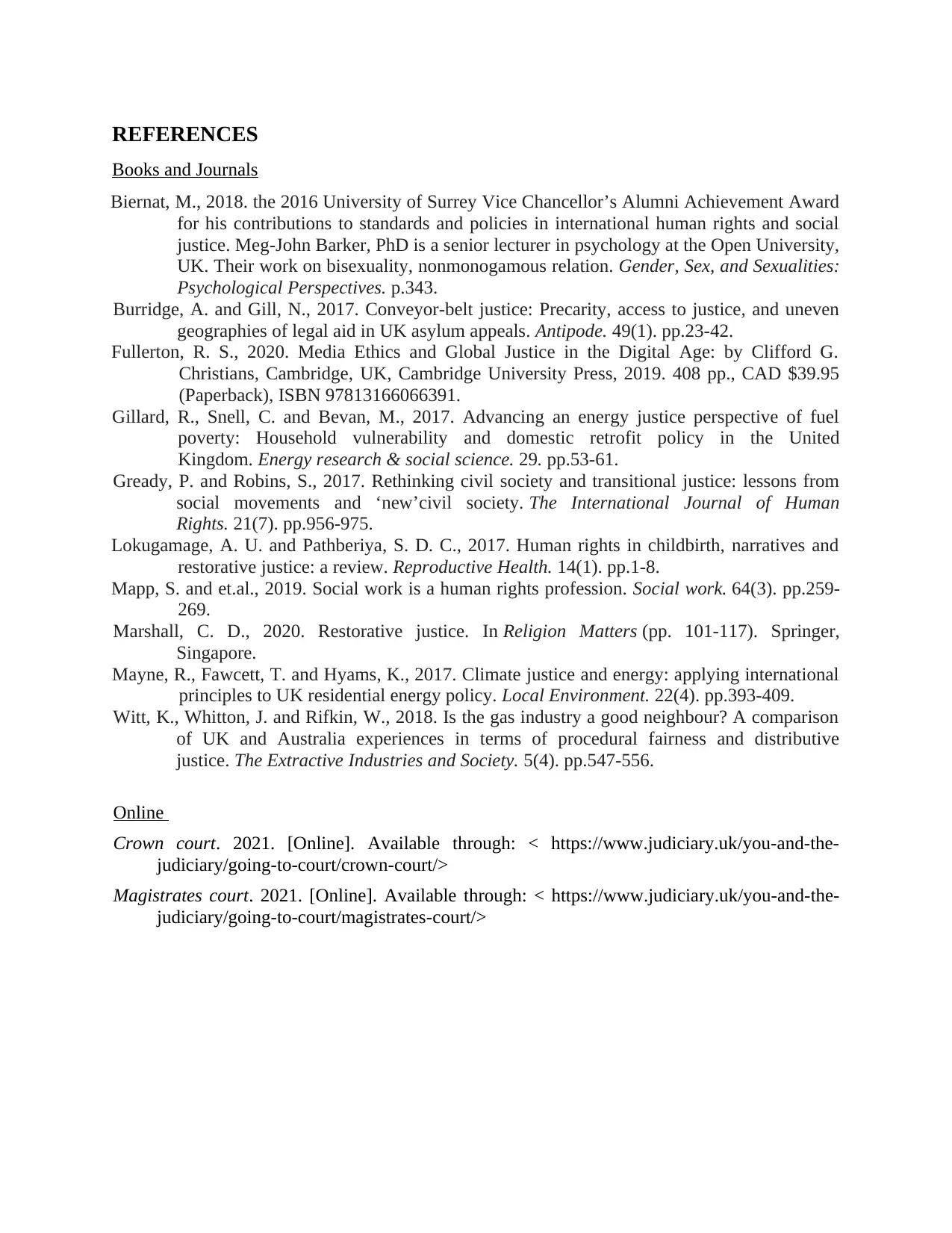
REFERENCES
Books and Journals
Biernat, M., 2018. the 2016 University of Surrey Vice Chancellor’s Alumni Achievement Award
for his contributions to standards and policies in international human rights and social
justice. Meg-John Barker, PhD is a senior lecturer in psychology at the Open University,
UK. Their work on bisexuality, nonmonogamous relation. Gender, Sex, and Sexualities:
Psychological Perspectives. p.343.
Burridge, A. and Gill, N., 2017. Conveyor‐belt justice: Precarity, access to justice, and uneven
geographies of legal aid in UK asylum appeals. Antipode. 49(1). pp.23-42.
Fullerton, R. S., 2020. Media Ethics and Global Justice in the Digital Age: by Clifford G.
Christians, Cambridge, UK, Cambridge University Press, 2019. 408 pp., CAD $39.95
(Paperback), ISBN 97813166066391.
Gillard, R., Snell, C. and Bevan, M., 2017. Advancing an energy justice perspective of fuel
poverty: Household vulnerability and domestic retrofit policy in the United
Kingdom. Energy research & social science. 29. pp.53-61.
Gready, P. and Robins, S., 2017. Rethinking civil society and transitional justice: lessons from
social movements and ‘new’civil society. The International Journal of Human
Rights. 21(7). pp.956-975.
Lokugamage, A. U. and Pathberiya, S. D. C., 2017. Human rights in childbirth, narratives and
restorative justice: a review. Reproductive Health. 14(1). pp.1-8.
Mapp, S. and et.al., 2019. Social work is a human rights profession. Social work. 64(3). pp.259-
269.
Marshall, C. D., 2020. Restorative justice. In Religion Matters (pp. 101-117). Springer,
Singapore.
Mayne, R., Fawcett, T. and Hyams, K., 2017. Climate justice and energy: applying international
principles to UK residential energy policy. Local Environment. 22(4). pp.393-409.
Witt, K., Whitton, J. and Rifkin, W., 2018. Is the gas industry a good neighbour? A comparison
of UK and Australia experiences in terms of procedural fairness and distributive
justice. The Extractive Industries and Society. 5(4). pp.547-556.
Online
Crown court. 2021. [Online]. Available through: < https://www.judiciary.uk/you-and-the-
judiciary/going-to-court/crown-court/>
Magistrates court. 2021. [Online]. Available through: < https://www.judiciary.uk/you-and-the-
judiciary/going-to-court/magistrates-court/>
Books and Journals
Biernat, M., 2018. the 2016 University of Surrey Vice Chancellor’s Alumni Achievement Award
for his contributions to standards and policies in international human rights and social
justice. Meg-John Barker, PhD is a senior lecturer in psychology at the Open University,
UK. Their work on bisexuality, nonmonogamous relation. Gender, Sex, and Sexualities:
Psychological Perspectives. p.343.
Burridge, A. and Gill, N., 2017. Conveyor‐belt justice: Precarity, access to justice, and uneven
geographies of legal aid in UK asylum appeals. Antipode. 49(1). pp.23-42.
Fullerton, R. S., 2020. Media Ethics and Global Justice in the Digital Age: by Clifford G.
Christians, Cambridge, UK, Cambridge University Press, 2019. 408 pp., CAD $39.95
(Paperback), ISBN 97813166066391.
Gillard, R., Snell, C. and Bevan, M., 2017. Advancing an energy justice perspective of fuel
poverty: Household vulnerability and domestic retrofit policy in the United
Kingdom. Energy research & social science. 29. pp.53-61.
Gready, P. and Robins, S., 2017. Rethinking civil society and transitional justice: lessons from
social movements and ‘new’civil society. The International Journal of Human
Rights. 21(7). pp.956-975.
Lokugamage, A. U. and Pathberiya, S. D. C., 2017. Human rights in childbirth, narratives and
restorative justice: a review. Reproductive Health. 14(1). pp.1-8.
Mapp, S. and et.al., 2019. Social work is a human rights profession. Social work. 64(3). pp.259-
269.
Marshall, C. D., 2020. Restorative justice. In Religion Matters (pp. 101-117). Springer,
Singapore.
Mayne, R., Fawcett, T. and Hyams, K., 2017. Climate justice and energy: applying international
principles to UK residential energy policy. Local Environment. 22(4). pp.393-409.
Witt, K., Whitton, J. and Rifkin, W., 2018. Is the gas industry a good neighbour? A comparison
of UK and Australia experiences in terms of procedural fairness and distributive
justice. The Extractive Industries and Society. 5(4). pp.547-556.
Online
Crown court. 2021. [Online]. Available through: < https://www.judiciary.uk/you-and-the-
judiciary/going-to-court/crown-court/>
Magistrates court. 2021. [Online]. Available through: < https://www.judiciary.uk/you-and-the-
judiciary/going-to-court/magistrates-court/>
1 out of 10
Related Documents
Your All-in-One AI-Powered Toolkit for Academic Success.
+13062052269
info@desklib.com
Available 24*7 on WhatsApp / Email
![[object Object]](/_next/static/media/star-bottom.7253800d.svg)
Unlock your academic potential
© 2024 | Zucol Services PVT LTD | All rights reserved.





